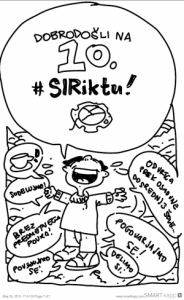Žan Močivnik, I. osnovna šola Celje, Celje
Pupils incorporate various technologies into their everyday life – mobile phones, tablets, smartwatches etc. Using their knowledge and simple aids they change their devices into true holograms. In multimedia lessons pupils used the mathematics software Geogebra to construct the net of a truncated pyramid that matched their smartphone screens dimensions. The net was printed on a transparent foil, cut out and put together. Pupils got to know the programming basics in the Scratch software: moving, enlarging, rotating. With the help of simple software they acquired the basics of programming, loops, software functions and the coordinate system. The knowledge of the latter is crucial in the programming process. After the introductory programming lesson the students wrote a short script where they predicted the whole movement of the figure, paying special attention to the movement in the hologram: enlarging the figure meant zooming in, while reducing it meant zooming out. The movement was limited by the screen diagonals. The pupils started by making a short animation for one outer surface, which was shown on the monitor, while checking its image in the hologram, making sure whether the animation corresponded to their script, all the while checking if it was properly shown inside the pyramid as a 3-dimensional figure with spatial effects with the help of light reflection properties. The programme had to be upgraded for the other three surfaces, thereby adding additional figures and taking into account the properties of reflections over the point and the line. The programmes were changed and corrected in terms of reflection of x and y coordinates. The validity of the final programme was rechecked on the hologram that was featured on the monitor. Classwork was mainly independent since the pupils used the software without any help from the teacher. The web version helped to make a bigger hologram onto a central computer where the solutions could be tested simultaneously. My role was to help pupils make a square regular pyramid and get to know the programming basics. The rest of the work was done independently by the pupils, where some of them rendered figures by themselves, which meant not only moving the figure but also rotating it. This method encouraged some pupils to create new items they meet in everyday life on different video channels.
